
ELISA Kits
- • Anemia ELISA kits
- • Allergy ELISA kits
- • Autoimmune Disease kits
- • Bone Metabolism ELISA kits
- • Blood bank ELISA kits
- • Cancer ELISA kits
- • Cardiac Markers ELISA kits
- • Diabetes Assays ELISA kits
- • Drug test ELISA kits
- • Fertility ELISA kits
- • Food ELISA kits
- • Infectious Disease ELISA kits
- • Other ELISA Kits
- • Parasitology ELISA kits
- • Steroid ELISA kits
- • Thyroid ELISA kits
Rapid Tests
- • Allergy Rapid tests
- • Bone Metabolism
- • Cancer Rapid tests
- • Cardiac markers Rapid tests
- • Drug Tests
- • Fertility Rapid tests
- • Hepatitis Panel
- • Infectious Disease & other tests
- • Other
- • Ovulation Rapid tests
- • Pregnancy tests
- • Urine Reagent Strips tests
IFA Kits
Chemiluminescence Immuno Assays
- • Allergy Assays
- • Autoimmune Thyroid Assays
- • Cardio-Vascular Monitoring
- • Diabetes Assays
- • Fertility Assays
- • Growth Deficiency
- • Infectious Disease Assays
- • Others
- • Steroid Assays
- • Thyroid Assays
- • Tumor Marker Assays
Serology Tests
- • ASO (Anti-Streptolysin-O)
- • CRP (C-Reactive Protein)
- • Mono (Infectious Mononucleosis)
- • RF (Rheumatoid Factor)
- • RPR (Rapid Plasma Reagin)
- • SLE (Systemic Lupus Erythematosus)
Instrumentation



H. Pylori Antigen ELISA Test
| Name |
H. Pylori Antigen ELISA test kit |
|---|---|
| Full name |
Human Helicobacter pylori Antigen Stool ELISA Test Kit |
| Category Name | Infectious Disease ELISA kits |
| Test | 96 |
| Method | ELISA: Enzyme Linked Immunosorbent Assay |
| Principle | ELISA: Indirect ELISA |
| Detection Range | Quantitative: 0-100 ng/ml |
| Sample | 100 ul Sample |
| Specificity | 100% |
| Sensitivity | 96% |
| Total Time | ~ 70 min |
| Shelf Life | 12 Months from the manufacturing date |
 |
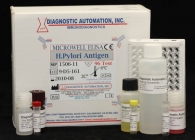 |
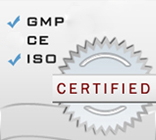 |
H. Pylori Antigen ELISA Test description:
The Diagnostic Automation Inc. ELISA, Helicobacter pylori Antigen (Ag) is a quantitative assay for the detection of H. pylori Ag in human stool specimen. The test results are intended to aid in the diagnosis of H. pylori infection, to monitor the effectiveness of therapeutic treatment and to confirm the eradication of H. pylori in peptic ulcer patients.
Materials Provided with H. pylori Antigen ELISA Kit:
1. Twelve 1x 8-well strips coated with purified anti H. pylori Ag antibody. The
strips are packaged in a strip holder.
2. Concentrated Extraction sample diluent (10 X, 11 ml in a blue cap vial),needs to be diluted before use.
3. Prediluted Calibrator 1,2,3,4,5,6 (0.6 ml for each)
4. HRP-conjugate (6 ml in a yellow cap vial).
5. Wash buffer (25 ml, in a clean cap vial) 30 x concentrate
6. TMB substrate solution (11 ml, in a black cap vial)
7. Stop solution (11 ml, in a white cap vial).
H. pylori ELISA Kit Background Information
Helicobacter pylori is a spiral bacterium cultured from human gastric mucosa identified by Marshall in 1982. Studies have indicated that the presence of H. pylori is associated with a variety of gastrointestinal diseases including gastritis, duodenal and gastric ulcer, non-ulcer dyspepsia, gastric adenocarcinoma and lymphoma. The organism is present in 95-98% of patients with duodenal ulcer and 60-90% of patients with gastric ulcers. Multiple studies have also demonstrated that removal of the organism by antimicrobial therapy is correlated with the resolution of symptoms and cure of diseases. Patients who present with clinical symptoms relating to the gastrointestinal tract can be diagnosed for H. pylori infection by two methods:
1. Invasive techniques include biopsy followed by culture or histologic examination of biopsy specimen or direct detection of urease activity.
2. Non-invasive techniques include urea breath tests and serological methods. Serologic tests are employed to detect antibodies as human immune response to H. pylori. Two methods appear to be of great interest regarding their use in H. pylori routine serology, namely the ELISA and the Western immunoblot because they offer the most versatility in regards to immunoglobulin specificity and relative ease of use.
H. pylori Antigen Elisa Test Kit Principle
Purified H. pylori antibody is coated on the surface of microwells. An aliquot of
diluted stool sample is added to wells, and the H. pylori antigens, if present,
bind to the antibody. All unbound materials are washed away. After adding
enzyme conjugate, it binds to the antibody-antigen complex. Excess enzyme
conjugate is washed off and TMB Chromogenic substrate is added. The
enzyme conjugate catalytic reaction is stopped at a specific time. The intensity
of the color generated is proportionated to the amount of H. pylori Ag in stool
sample.
H. Pylori Antigen Elisa Test Results Interpretation
Minimum detectable concentration: 0.5ng/ml
Negative: < 15 ng/ml
Positive: > 20 ng/ml
Medium Positive: 20-100 ng/ml
H. pylori Antigen elisa Related test Kits:
H. pylori IgA ELISA kit
http://www.rapidtest.com/index.php?i=H.-pylori-ELISA-Test&id=141&cat=16
H. pylori IgG ELISA kit
http://www.rapidtest.com/index.php?i=H.-pylori-ELISA-Test&id=140&cat=16
H. pylori IgM ELISA kit
http://www.rapidtest.com/index.php?i=H.-pylori-ELISA-Test&id=142&cat=16
H. pylori Rapid Tests
H. Pylori Rapid Test (Cassette Serum) 118561-1
http://www.rapidtest.com/index.php?i=H.-Pylori-Rapid-Test--Serum---(Cassette)-&id=387&cat=26
H. Pylori Rapid Test (Cassette Serum / Whole Blood Test) 118562-1
http://www.rapidtest.com/index.php?i=H.-Pylori-Rapid-Test-(Cassette-Serum-/-Whole-Blood-Test)&id=668&cat=26
H. Pylori Antigen Rapid Test (Cassette) 118564-1
http://www.rapidtest.com/index.php?i=H.-Pylori-Antigen-Rapid-Test-(Cassette)-&id=388&cat=26
Diagnostic Automation Inc. also provides other Test Kits:
http://www.rapidtest.com/index.php?product
For more information about ELISA Kits, Rapid Tests, IFA Kits, CLIA Test Kits, or Serology tests, please see our website home page, or contact our Customer Service Representative
at 818-591-3030.
Product Note:
At least half the world's populations are infected by H. pylori, making it the most widespread infection in the world. Actual infection rates vary from nation to nation. The developing world has much higher infection rates than the West, including Australasia, North America, and Europe where rates are estimated to be around 25%.
Pounder RE, & Ng D (1995). Aliment. Pharmacol. Ther. 9 (Suppl 2): 33–9. PMID 8547526
The age at which H. pylori is acquired seems to influence the possible pathologic outcome of the infection. People infected with it at an early age are likely to develop more intense inflammation leading to atrophic gastritis with a higher subsequent risk of gastric ulcer, gastric cancer or both. Acquisition at an older age brings different gastric changes more likely to lead to duodenal ulcer.
Brown LM (2000). Epidemiol Rev 22 (2): 283–97. PMID 11218379
Up to 85% of people infected with H. pylori never experience symptoms or complications
Bytzer P. etal., ( 2011). Dan Med Bull 58 (4): C4271. PMID 21466771
Our H. Pylori Antigen ELISA KIT with high sensitivity and specificity is a great tool for detecting H. pylori infection.
H. Pylori Antigen ELISA KIT INTENDED USE
Diagnostic Automation Helicobacter pylori Antigen ELISA is a quantitative assay for the detection of H. pylori antigens in human stool specimen. The test results are intended to aid in the diagnosis of H. pylori infection, to monitor the effectiveness of therapeutic treatment and to confirm the eradication of H. pylori in peptic ulcer patients.
SUMMARY AND EXPLANATION OF THE TEST
Helicobacter pylori is a spiral bacterium cultured from human gastric mucosa by Marshall in 19821. Studies have indicated that the presence of H. pylori is associated with a variety of gastrointestinal diseases including gastritis, duodenal and gastric ulcer, non-ulcer dyspepsia, gastric adenocarcinoma and lymphoma. The organism is present in 95-98% of patients with duodenal ulcer and 60-90% of patients with gastric ulcers. The studies have also demonstrated that removal of the organism by antimicrobial therapy is correlated with the resolution of symptoms and cure of diseases2.
Patients who present with clinical symptoms relating to the gastrointestinal tract can be diagnosed for H. pylori infection by two methods:
1) Invasive techniques include biopsy followed by culture or histological examination of biopsy specimen or direct detection of urease activity. The cost and discomfort to the patients are very high and biopsy samples are subject to errors related to sampling and interference of contaminated bacteria.
2) Non-invasive techniques include urea breath tests (UBT)3 and serological methods4. The UBT requires a high density and active bacteria and should not be performed until 4 weeks after therapy to allow resisdual bacteria to increase to the detection level. The main limitation of serology test is the inability to distinguish current and past infections.
Our H. Pylori Antigen ELISA KIT have high sensitivity and specificity.
ELISA kits - Rapid tests- Drug tests- Pregnancy test - IFA kits - CLIA assays - Serology tests - Instrumentation
©1992 Diagnostic Automation/Cortez Diagnostics Inc. All rights reserved.


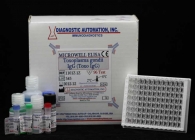 Toxo IgG ELISA kit
Toxo IgG ELISA kit
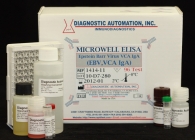 Epstein Barr Virus VCA IgA (EBV, VCA IgA) ELISA test kit
Epstein Barr Virus VCA IgA (EBV, VCA IgA) ELISA test kit
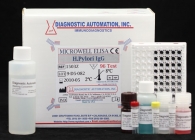 H. pylori IgG ELISA Test
H. pylori IgG ELISA Test
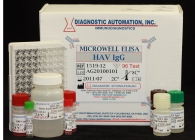 HAV IgG ELISA kit
HAV IgG ELISA kit
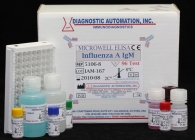 Influenza A IgM ELISA kit
Influenza A IgM ELISA kit








